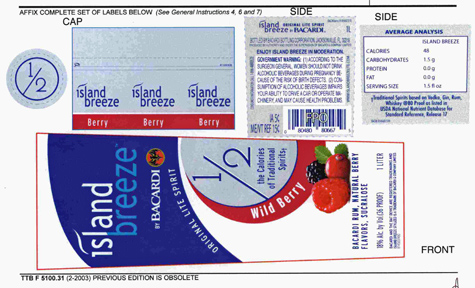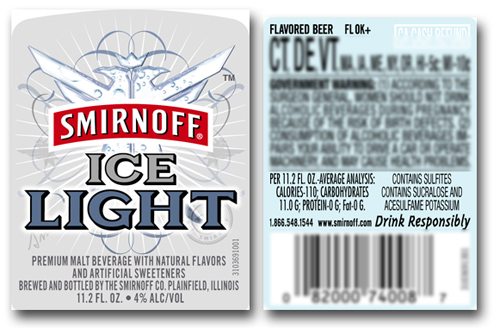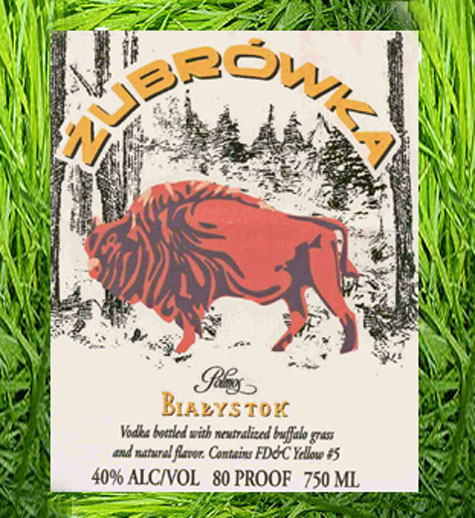This Bacardi Island Breeze label blew in with a bang, in late 2005, and blew out quickly thereafter. Bacardi apparently had big plans for this “lite spirit.” The company booked Kim Cattrall for print and TV ads. But just a few years later, there is almost no trace of this brand or the ads. This label remains significant because it is one of the very few that refers to a Serving Size of 1.5 fluid ounces, and the “USDA National Nutrient Database.” TTB is moving toward requiring this information, in an expanded way, on all alcohol beverage labels. Diageo has pointed to this label and grumbled that it should be allowed to do something similar, too. This product is also one of very few using sucralose as a sweetener.
Continue Reading Leave a Commentingredients
Serving Facts on Bacardi Island Breeze

Tags: ingredients, legally interesting/controversial, policy, serving facts/allergens
Sucralose and Ace K

The back label says CONTAINS SUCRALOSE AND ACESULFAME POTASSIUM. The front label says PREMIUM MALT BEVERAGE WITH NATURAL FLAVORS AND ARTIFICIAL SWEETENERS. We think this is noteworthy due to the unabashed use of artificial sweeteners. Perhaps this marks a trend toward a much wider use of artificial sweeteners, in beverages so commonly sweetened with sugar over so many centuries. It is partly a liberalization, on the part of FDA and TTB, allowing a wider variety of sugar substitutes. It may also be due to forward-thinking companies getting way out in front of the eventual need to disclose calories and carbohydrates. IFIC says sucralose is 600 times sweeter than sugar, derived from sugar and:
can be used in place of sugar to eliminate or reduce calories in a wide variety of products. … Sucralose was discovered in 1976. … In 1998, [FDA] approved the use of sucralose in 15 food and beverage categories — the broadest initial approval ever given to a food additive.
Acesulfame Potassium, according to Wiki, is:
Continue Reading Leave a Commenta calorie-free artificial sweetener, also known as Acesulfame K or Ace K (K being the symbol for potassium), and marketed under the trade names Sunett and Sweet One. … It was discovered accidentally in 1967 by German chemist Karl Clauss at Hoechst AG (now...
Tags: ingredients, policy, serving facts/allergens
Zubrowka

An anonymous reader wrote to us about this Zubrowka label as follows:
Free Range Vodka? As if there weren’t already enough confusion with health food terms like organic, natural, cage-free, and free-range, we’ve found a product that extends the health craze to alcoholic beverages. Meet Zubrowka, bottled with “neutralized” buffalo grass. What exactly is neutralized buffalo grass? Well, your guess is as good as ours. But if one were to assume that by neutralizing it, it is rendered somewhat inactive or less potent, that begs the question, why bother adding the ingredient in the first place? So, the purpose of adding a neutralized ingredient is definitely curious, but the label’s image may give us some clues. The image of a large, muscular, and almost fearsome bison dominates the label. One could assume the message here is that by ingesting the very essence of what these imposing creatures thrive on, the drinker would too be infused with virility and strength.
In fact, there is a good reason it’s neutralized. Real bisongrass raises serious health concerns as suggested by Bill Dowd here. Zubrowka is native to Poland and goes back at least 500 years.
Continue Reading Leave a CommentPine Liqueur, Pine Beer, Fir Brandy

Here we present several members of the pine family. Above is Clear Creek Eau de Vie of Douglas Fir. It is made in Portland, Oregon. Clear Creek explains how it’s made:
Inspired by an obscure Alsatian distillate called Eau de Vie de Bourgeons de Sapin, Steve McCarthy worked on developing the perfect Oregon version of a tree spirit, an Eau de Vie of Douglas Fir, for ten years. This eau de vie is made from an infusion of the springtime buds of Douglas fir picked by hand into clear brandy which is then re-distilled and re-infused with more buds. Finally it is strained and bottled. The green color and complex fresh flavor are from the Douglas Fir buds. No artificial colors or flavors are added.
Mandrin, by contrast, is a malt beverage made in France, and “brewed with Pine Needles.” A third example is Zirbenz, the Stone Pine Liqueur of the Alps. The Zirbenz website has a lot of surprising information about the stone pine — the “Agave of the Alps”:
Continue Reading Leave a Commentthe Arolla Stone Pine can withstand temperature extremes down to minus 40 Celsius. … the tree may take over thirty years before producing fruit, and thereafter has a harvest cycle of five to seven years. In the interest...
Tags: ingredients
Diamonds, Gold & Vodka: What Recession?

One is filtered through diamonds and the other has gold flakes in the bottle. Double Cross Vodka is made in the Slovak Republic, where it is “filtered with diamond dust.” The small red strip label says so. Thanks to The Intoxicologist and Emily Haile for bringing this to our attention. Luxist explains:
The seven-times-distilled spirit uses only 100 percent organic, estate-grown winter wheat and mountain spring water drawn from aquifers located 200-feet below ground level. Double Cross’ diamond dust filtration system is said to provide unprecedented filtration capability because of the “unique shape and sub-micron size of the diamond dust particles.”
Rather than filter through the costly substance and leave it at the distillery, Gold Flakes Vodka puts the 24 karat gold right in each bottle. Luxist says it will retail for about $60 per bottle.
Continue Reading Leave a CommentTags: business strategy, ingredients, processing
Spirits from the Deep Oceans

Rogue Spirits makes a Dead Guy Whiskey “Ocean Aged in Oak Barrels for 1 Month.” Is it a gimmick or a good idea? Let’s just say they are not alone in searching high and low to make innovative products. Ocean Vodka “uses deep sea water from Hawaii” according to Luxist. “The water is drawn from 3,000 feet below the surface of the Pacific Ocean … to be devoid of surface pollutants.” Montanya Distillers is headed in the other direction. They make Mountain Rum in Silverton, Colorado, where it is “altitude aged” far from the seas.
Continue Reading Leave a CommentTags: ingredients, processing

